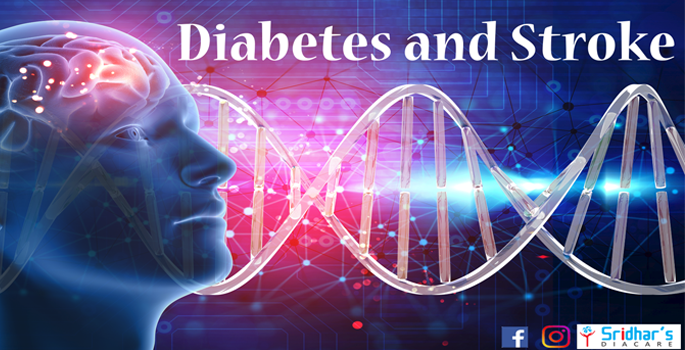
Before we talk about diabetes and stroke, one must understand actually what a stroke means. Stroke is the result of a sudden change in the blood supply to a part of the brain, sometimes causing a loss of ability to move a particular part of the body. A Stroke happens when there is a loss of blood flow to part of the brain. Brain cells cannot get the oxygen and nutrients they need from the blood and they start to die within a few minutes. This can cause lasting brain damage, long term disability and even death. The commonest types of stroke include Ischemic stroke and Hemorrhagic stroke. Ischemic stroke is caused by a blood clot that blocks a blood vessel in the brain. This is the commonest and about 80% of strokes are Ischemic. Whereas, Hemorrhagic strokes are caused by a blood vessel that breaks and bleeds into the brain.
What are the commonest risk factors for a stroke or who is at maximum risk?
The major risk factors include diabetes mellitus, high blood pressure, heart diseases like atrial fibrillation can cause blood clots that lead to stroke, smoking – smokers have high risk because smoking damage your blood vessels and raises your blood pressure, family history of stroke or transient ischemic attacks. Age – as you get older, your risk for stroke increases. Alcohol and illegal drug usage, lack of physical activity or exercise, high cholesterol levels, obesity and unhealthy dietary habits.
What are the commonest symptoms of stroke?
Sudden numbness or weakness of face, arm or leg, especially on one side of the body
Sudden confusion, trouble in speaking or understanding speech
Sudden visual disturbance in one or both eyes
Sudden difficulty in walking
Dizziness, loss of balance and coordination etc
Sudden severe headache with no known cause
Now we must know how diabetes causes a stroke. Diabetes is a well-established risk factor for stroke. Diabetes causes various micro and macrovascular changes in the patient often culminating in major clinical complications and one of them is stroke. Diabetes can cause pathological changes in blood vessels at various locations and can lead to stroke if cerebral vessels are directly affected. The various possible mechanisms in diabetes that can lead to stroke include vascular endothelial dysfunction, increased early age arterial stiffness, systemic inflammation and thickening of the capillary basal membrane etc. Vascular endothelial function is critical for maintaining structural and functional integrity of the vessel walls as well as vasomotor control. Nitric oxide mediates vasodilatation and its decreased availability can cause endothelial dysfunction and thereby atherosclerosis. Nitric oxide-mediated vasodilatation is impaired in individuals with diabetes possibly due to increased inactivation of nitric oxide or decreased reactivity of smooth muscles to nitric oxide. Hence diabetic patients usually have stiffer arteries and decreased elasticity of vessels.
How do you diagnose a stroke?
Apart from a thorough clinical neurological examination of a patient, various other biochemical and imaging studies are done to establish a clear diagnosis of the type of stroke. Biochemical tests include blood sugars, lipid profile, renal function test, complete hemogram, bleeding and clotting profile etc. An electrocardiogram provides information about the heart rate and rhythm to rule out arrhythmias etc. A CT or MRI scan provides valuable information on the type, site, pattern and severity of stroke. An ultrasound examination can show problems in the carotid arteries which carry blood from the heart to the brain. A cerebral arteriogram gives the exact site of the extent of narrowing or obstruction in the arteries.
How do you treat stroke?
The only approved treatment for acute ischemic stroke is a thrombolytic agent called Tissue Plasminogen Activator or TPA, which must be given within the first 4 hours of the onset of stroke symptoms. Also, several new drugs may stop or reverse brain damage if administered immediately. It dissolves the clot that is clogged in the artery and can restore blood flow to the brain tissue. Carotid endarterectomy is another surgical treatment option wherein the plague is removed from inside your carotid artery which supplies much blood to your brain. Another treatment option is carotid angioplasty and stenting where a deflated balloon is inserted into the artery to expand its wall and then place the stent which holds the artery open.
The most important aspect of stroke management in post-stroke rehabilitation or physiotherapy. This is very important in helping the patient to get back the motor function that is lost due to a stroke.
How do you prevent stroke?
The most important things that you need to do to prevent a stroke is to avoid smoking, control your blood sugar levels properly, maintain a healthy body weight, exercise regularly, keep your blood cholesterol levels under control, have your blood pressure checked frequently and kept under normal limits, limit your alcohol intake, take preventive medicines like low dose aspirin etc if recommended by your doctor.

